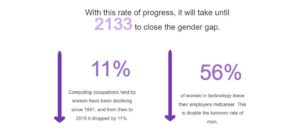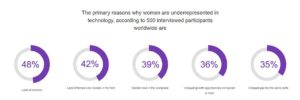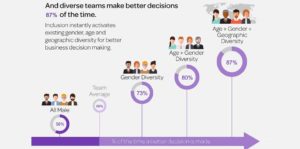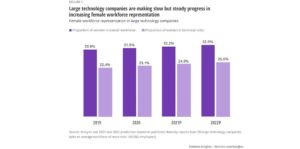March 8th, 2022
Category: Innovation
No Comments
Posted by: Team TA

Synopsis
Gender parity is critical for progress in all areas, including technology, business, finance, legislation, and the startup sector. Despite the fact that we publish stories every year about making the world a more equitable place, the tech industry has long been and continues to be a male-dominated field. This article will expose you to some brilliant women who have made significant contributions to technology, the obvious gap between men and women in the field, the need for more women and the future of women in IT.
“There is no limit to what we, as women, can accomplish.”
-Michelle Obama
“Women have ideas, and to put those ideas into action, they need a place at the table,” Frances McDormand famously quoted during her Oscar acceptance speech for Best Actress. The tech industry, like many others, has historically been dominated by men, with women accounting for only 25% of all employment. This is due to a variety of circumstances, including women’s late ability to pursue their education without prejudice and to be admitted to the STEM area (Science, Technology, Engineering, and Math) – which was only made a legal right in the 1970s.
Other factors include a large gender pay gap, in which women are paid 28% less than their male counterparts and obtain fewer promotions while being equally qualified, forcing women to quit the tech profession twice as often (56%). Despite this, women continue to thrive in the tech field, breaking boundaries and changing the environment. The uphill battle is nothing new, and despite all the barriers, women have always triumphed and altered the world.
As we celebrate International Women’s Day this year, let us look at the extraordinary women who have paved the way in technology.
Champions of Change: Women who changed the Tech World
For decades, women have been generating ground-breaking technological innovations, blazing trails, and making history. But their stories aren’t always the ones we’re familiar with. Today, we’re honoring five women in technology who have made significant contributions to the tech industry throughout the years.
These are some of the extraordinary female leaders in technology you should be aware of.
-
Ada Lovelace
Born in 1815, as the daughter of the romantic poet, Lord Byron and Anna Isabella, Ada was the world’s first computer programmer. Her written notes outlining how the notion of an engine transitions calculation to computation, made her one of the most famous women in technology and is even referred to as the “Prophet of the Computer Age”. Every second Tuesday in October is known as Ada Lovelace Day, to celebrate the achievements of women in STEM careers. Her aptitude for mathematics was evident early in life, and her skills and interest in machines led to a collaboration with Charles Babbage.
The “Analytical Engine,” a complex device that resembled the elements of the modern computer but was never built, was invented by Babbage. Ada is often referred to be the “world’s first computer programmer” as a result of her contributions to the project. Ada Lovelace’s notes on the Analytical Engine inspired Alan Turing’s work on the first modern computer in the 1940s.
-
Annie Easley
One of the first Black Americans to work as a NASA rocket scientist, and a trailblazer for gender and racial diversity in STEM, Annie Easley designed and implemented code that led to the invention of the battery used in the first hybrid cars. Easley began her career as a “human computer,” assisting researchers with calculations. As a computer scientist, she had contributed to a variety of programs, inspired others through her active involvement in outreach programs, and broken down barriers as an equal employment opportunity counselor. While at NASA, Easley’s work on the Centaur rocket project laid the groundwork for future space shuttle launches.
-
Hedy Lamarr
Famous actress and self-taught inventor, Hedy’s greatest invention was the Secret Communication System, a frequency hopping device, that she created with the help of George Antheil. The key purpose of this device was to set radio-guided torpedoes off course during WWII, laying the groundwork for today’s Wi-Fi and Bluetooth communication technologies.
-
Adele Goldberg
Adele was a key figure in the development of the Smalltalk-80 programming language, which was used to create one of the first modern Graphics User Interface (GUI) with windows, icons, menus, and pointers (WIMP), and which inspired the first Apple computer. Adele and her colleagues pioneered concepts that provided the cornerstone for the graphical user interfaces (GUI) that we use every day.
-
Dr. Radia Perlman
Dubbed as the “Mother of the Internet”, Radia’s invention of the algorithm behind the Spanning Tree Protocol (STP), was instrumental in making today’s internet possible. Her work had a significant impact on how networks self-organize and move data, as well as establishing the fundamental laws of internet traffic. Radia has given keynote addresses all around the world and continues to work as a computer programmer and engineer for Dell EMC.

Despite the fact that there have been several outstanding women who have made significant contributions to technology, the numbers are extremely low. Is the situation still the same after all these years? The gender gap in technology has risen dramatically over the previous three decades, creating global worry about the health of the IT industry’s openness. Women’s employment in computing has been dropping since 1991, and it fell by 11% between 1991 and 2018.

(Image regards: https://adevait.com/state-of-women-in-tech)
Global Gender Situation: What the Data Says!
Women make up 35% of STEM students worldwide, and 29.3% of those engaging in scientific research and development (R&D). According to the data from Adevait, women hold 25% of all occupations in the technology business. Despite the fact that there are a few well-known women in top positions, such as Sheryl Sandberg, Facebook COO, or Susan Wojcicki, YouTube CEO, females make up just 21% of the whole workforce at the Executive level. It is also clear that Top Tech businesses struggle to close the gender gap — only 7% of Stack Overflow Developers were female, only 6% of GitHub user profiles are female, and only 18% of women employees at Google work in technical capacities.
Furthermore, according to a survey conducted by Accenture and Girls Who Code in 2020, 50% of women depart technology employment by the age of 35, and females abandon tech roles at a 45% higher rate than men. Only 21% of the women in the research thought the technology business was a place where they might succeed.
According to the interviews with 500 participants worldwide, some of the primary reasons why women are underrepresented in technology are the lack of mentors (48%), the lack of female role models in the field (42%), gender bias in the workplace (39%), unequal growth opportunities compared to men (36%) and the unequal pay for the same skills (35%). These factors clearly demonstrate the path in which the industry can progress.

(Image regards: https://adevait.com/state-of-women-in-tech)
The Need for Women in Tech: Impact of having more Women in Technology
We need more women in technology, according to Jyoti Choudrie FBCS, Professor of Information Systems at the University of Hertfordshire, since they can provide a more balanced picture of female gender and technology sector concerns. When the media, academia, and industry focus solely on one gender, issues that females may identify with and address are usually overlooked.
If 50% of our population is missing from the conversation, organizations may miss out on opportunities for increased creativity, innovation, efficiency, and more. They might also overlook untapped markets. Adopting gender diversity can assist companies in reaping far-reaching benefits.
The value of women in technology can range from new perspectives to a direct impact on a company’s bottom line. Here are a few examples of how bringing more women into the IT sector can help companies achieve their objectives.
Diversity of thought
Collaboration between people of different genders, sexual orientations, nationalities, and races can improve problem-solving and innovation. According to research, diversity in teams helps teams make better business decisions 73% of the time. Gender diversity shines a brighter light on an organization’s strengths and weaknesses. Because of this increased awareness, gender-diverse teams can be more efficient and capable of making critical decisions twice as fast and in half the time. Gender diversity can assist businesses in reaping these far-reaching benefits and bringing different perspectives to the table.

(Image regards: www.cloverpop.com)
Like-Minded approach to product development
Despite the fact that women make up over half of the population, there are only a few women in the tech business who can influence consumer product design. When it comes to designing goods for women, men are less likely to understand their needs.
More females occupying roles in information technology leads to improved organizational outcomes. As technology advances, companies will be better equipped to represent women and their needs as customers. The growing consumer base and where they choose to spend their money could have a big impact on the companies’ success. Consumers who identify as men can benefit from gender diversity in the tech industry just as much as consumers who identify as women. Gender equality in the business can benefit consumers who identify as women while also potentially boosting the economy.
More role models
Being a woman in IT isn’t always easy, and being the only woman in the boardroom can put you under a lot of stress. By celebrating female tech leaders, it will potentially motivate more females to follow their interests and professions in tech, thereby boosting the hiring pool diversity. Strong role models of other successful women can ensure young girls that women have a seat at the table so they can engage males on the topic of gender equality.
Future of Women in Tech: How can you make it better?
At the current rate of progress, it is anticipated that closing the gender gap completely will take until 2133. In 2030, 1.6 million young women are estimated to enter the IT industry. Many firms are recognizing the benefits of gender diversity in the workplace, and the IT industry is no exception. A larger talent pool, a diversity of perspectives, improved recruitment and reputation (85% of female millennials say having an employer with a strong record on diversity is important to them), and increased profitability are some of the most visible benefits from the employer’s perspective (according to McKinsey, the most gender-diverse companies are 21 % more likely to experience above-average profitability).

(Image regards: www2.deloitte.com)
But that isn’t enough; women continue to remain underrepresented in technology. To address this:
- People must be educated about technology and its role in shaping the world
- Increase access to tech careers, raise the visibility of female role models in the industry
- Level the playing field for women so that they can reach their full potential
- End damaging dialogues that perpetuate the stereotype that tech is only for men
Forcing women to work in tech is likewise not a realistic solution. Rather, it should be a campaign to raise awareness of the current situation, highlight the opportunities for development, and promote the benefits of gender diversity. Having support and recognition for what women bring to the technology table should assist in gradually but steadily closing the gender gap.
Bottomline
Our lives are increasingly globalized, and technology has an impact on everything we do. It influences how we go about routine chores like shopping and banking. It has an impact on how we learn, interact with others, and process news and information. Many still believe that positions in the IT industry are just for men. “After all, men are capable of thinking critically.” Women are driven by their emotions and lack the ability to work with mathematics. For decades, this type of misconception has been reinforced in our society, widening the gender gap in the IT business.
Fortunately, there are clear developments in this area, and women demonstrate that gender has nothing to do with their expertise in a certain sector. It frequently affects who has access to resources and opportunities. Technology has the potential to be a tremendous equalizer, but only if it is driven by diverse and mindful producers. Gender equality and diversity must also be seen as a way for businesses to improve their performance. We cannot rely on time alone to solve this issue; we have work to do if we are to #breakthebias.
Cheers, Women’s Day wishes!!